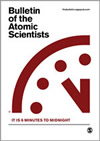 |
.
By Hans M. Kristensen
It’s interesting scary what you can find on the Internet: On Thursday, a Canadian calling himself SinoSoldier posted a report on the Pakistani web site Pakistan Defense claiming that China had test launched a JL-3 submarine-launched ballistic missile (SLBM) from a submarine in the Atlantic (!). Different versions allegedly have ranges from 12,000 km to 20,000 km and carry 5-7 warheads as opposed to 10 on the JL-2 SLBM. The source was said to be a report in the Japanese newspaper Yomiuri Shimbun.
 |
| Click image to download |
I haven’t been able to find the original story, but the report in Pakistan Defense is completely wrong: China does not have a JL-3 missile; it does not have a Type 096 submarine; it has never operated a submarine in the Atlantic; its two types of SLBMs (JL-1 and JL-2) have ranges of 1,770 km and 7,200 km, respectively; and they are only equipped with one warhead each.
The flaws in the report unfortunately did not prevent it from being picked up by Undersea Enterprise News Daily, an email newsletter distributed by the U.S. Atlantic submarine fleet headquarters.
Instead, check out our latest Nuclear Notebook on Chinese nuclear forces, just published for the Bulletin of the Atomic Scientists by Sage Publications: Chinese Nuclear Forces, 2010 (pdf version)
This publication was made possible by a grant from Carnegie Corporation of New York and Ploughshares Fund. The statements made and views expressed are solely the responsibility of the author.
The FY2026 National Defense Authorization Act (NDAA) paints a picture of a Congress that is working to both protect and accelerate nuclear modernization programs while simultaneously lacking trust in the Pentagon and the Department of Energy to execute them.
While advanced Chinese language proficiency and cultural familiarity remain irreplaceable skills, they are neither necessary nor sufficient for successful open-source analysis on China’s nuclear forces.
Satellite imagery has long served as a tool for observing on-the-ground activity worldwide, and offers especially valuable insights into the operation, development, and physical features related to nuclear technology.
This report outlines a framework relying on “Cooperative Technical Means” for effective arms control verification based on remote sensing, avoiding on-site inspections but maintaining a level of transparency that allows for immediate detection of changes in nuclear posture or a significant build-up above agreed limits.